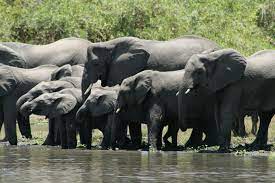Zimbabwe Parks and Wildlife Management Authority (ZimParks) is reviewing the Community Areas Management Programme for Indigenous Resources (CAMPFIRE) programme to give more power to communities who bear the brunt of coexisting with wildlife.
CAMPFIRE was conceived in 1982 by the then Zimbabwe’s Department of National Parks and Wildlife Management for the long term development management and sustainable utilisation of natural resources in the communal area by allowing communities to benefit directly from such exploitation.
The programme is managed through rural district councils who distribute contracts for safari hunting and tourism and allocate revenue to local wards.
However, poaching, low revenues to communities, weakening appeal, low donor support have emerged as some of the challenges that affect the successful implementation of the CAMPFIRE.
ZimParks spokesperson, Tinashe Farawo confirmed the authority has been receiving help from the African Wildlife Foundation (AWF) to review the programme.
“In terms of what needs to be done, AWF has been assisting us to review the CAMPFIRE programme and I’m sure the (Environment, Climate Change, Tourism and Hospitality Industry) minister (Mangaliso Ndlovu)will announce at the appropriate time, the new arrangements in terms of giving power to the communities. To say what needs to be done, what communities can do to deal with these problems because people will bear the brunt of sharing borders with wildlife land in Zimbabwe,” he said.
Farawo noted that land ownership in Zimbabwe was in three tiers but lamented that space was not expanding yet animals and human populations were.
“There is state land, which we manage on behalf of the people of Zimbabwe, there is rural district land and private land. 91 percent of our animals are on state land and I think about five percent on private land and then balance is on rural district council land so that is how land is distributed,” he said.
“We need to balance this. We must not pretend not to see what is happening or the challenges that are facing. If you go to Karoi, it is not what it was 30 years ago. We saw pictures of elephants moving in Kariba township last week but this was not happening 50 years ago.”
The ZimParks spokesperson said due to this, communities who lived with wildlife expected to benefit.
“We need to be true to ourselves. Animals and people are increasing, how do we balance that’s the challenge because if you go to Hwange now people want jobs. They want to survive, send their children to school, clinics, indeed we are rich but we don’t know how much we are worth,” Farawo noted.
He also indicated the World Bank was trying to assist the authority in ascertaining the value attached to wildlife.
“How much an elephant is worth, no one knows but you say you are rich? As long as our people are not benefiting they will never attach value to those things they will just say, ‘ah it’s one of those.’ In fact they will describe the elephants and the lions as pests because they are killing their people and destroying crops.”
Dr Collen Matema from AWF Community Conservation explained that the new model preferred by conservationists was called Community Based Natural Resource Management (CBNRM), which revolved around common property sharing.
“In other words, how can we manage the property that belongs to many of us and not to any single one of us, when a property is controlled by the group. CBNRM is based on the fact that if we put governance structures correctly and there are good incentives, the expectation is we have revenue generation, then development, which would then culminate into an improved conservation,” he said.
Dr Matema said this was how community business resources management programmes worked.
“It all revolves around issues to do with governance. How do we manage natural resources as people and how do we access the benefits as a community or as individuals within a community. And again, it goes back to issues around devolution, participation of the community members and issues of transparency where there is a need to know. For example, how much has been generated, also issues to control corruption and accountability, as well as building capacity. These are principles that would make a community based initiative more successful,” said the conservationist.

